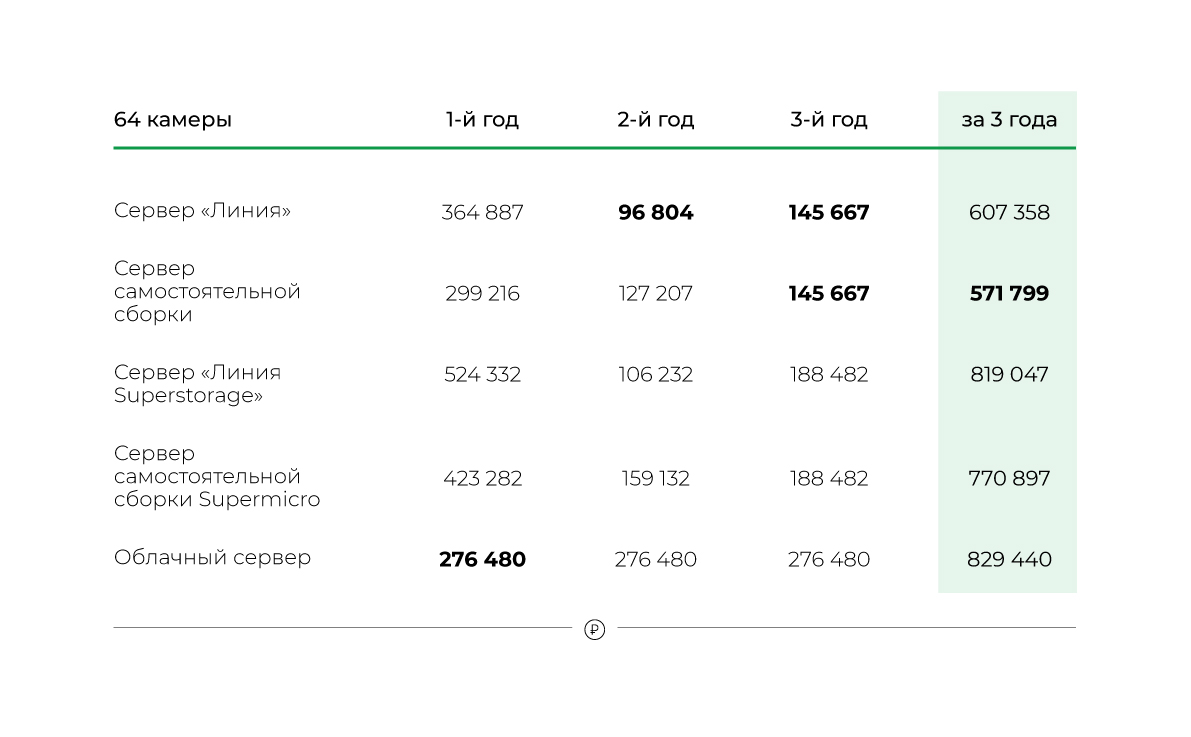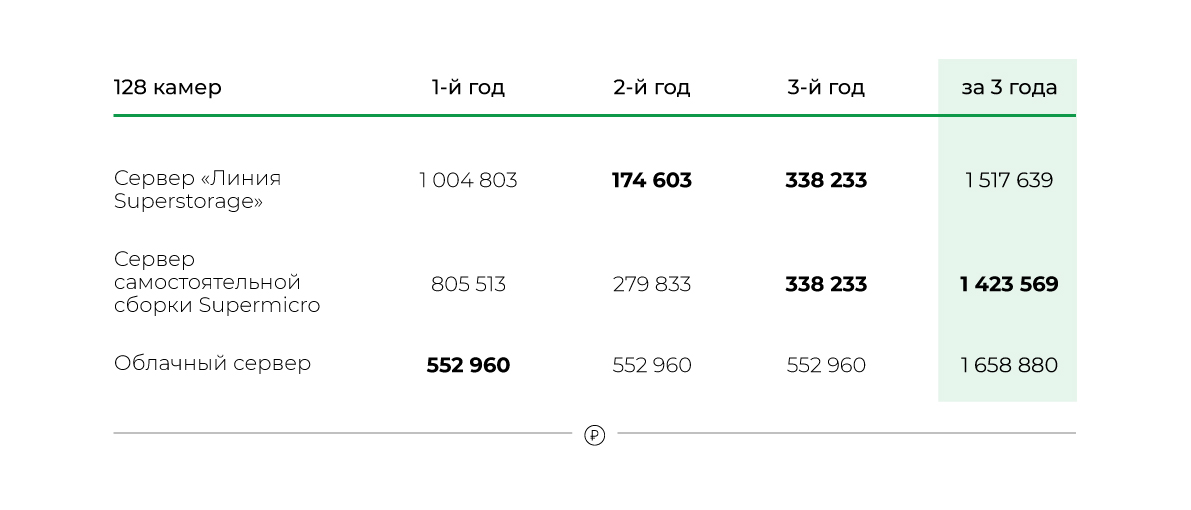What objects should use cloud video surveillance?

Recently, people increasingly prefer to rent. They rent apartments to be more mobile. Choose car sharing instead of expensive own car maintenance. They rent a cloud instead of storing files on their smartphones.
Does the same principle work with video surveillance? We conducted an analysis of the case in which it would be advisable to abandon our own video server in favor of cloud-based video surveillance.
Three types of objects were taken for the study: small (16 cameras), medium (64 cameras) and large (128 cameras) - and three years of active use. Evaluated the server self-assembly, as well as stationary and cloud video servers "Line" without taking into account the cost of surveillance cameras.
The prices for the equipment listed below are relevant at the end of 2018 and depend on the required computing power of the servers for the guaranteed operation of a certain number of cameras. The cost of cloud video surveillance was taken into account from the current lease rates of the cloud server "Lineia" , which start at 90 rubles per month (including 7 days of archive storage) and depend on the number of cameras and their bit rate.
The analysis was carried out according to five main parameters:
1. Server cost, which was calculated, as mentioned above, based on the number of cameras on a particular object and their characteristics.
2. Cost of hard drives for recording an archive with a depth of 7 days of continuous recording from all cameras connected to the system.
It is important that when renting a cloud server “Line” the archive is limited not by seven days, but by the disk space allocated for the recommended camera bitrate of 2 Mb / s with round-the-clock continuous recording of the archive. If you set up a detection record in a zone with low activity, then the selected archive depth may be enough for 3-4 weeks or more.
3. The cost of electricity for the maintenance of equipment and ensure its continuous operation at the facility.
4. Internet- 10, 30, 50 Mbps for small, medium and large objects, respectively. If the recording will be made to a centralized server, then the recommended total bit rate from the cameras will be 36, 144, 288 Mb / s. The cost of such Internet speed in different regions can vary greatly. Therefore, the minimum tariff was used for the calculation.
5. Service replacement is the most controversial item to which it is impossible to find a universal formula for cost planning. Let us dwell on it in more detail.
The server can work stably all its life, and can fail in six months. Even if the equipment is under warranty, replacement will take time and nerves. Proceedings with the supplier may be delayed not for one month, but simple in some cases is critical. The user has to buy a new server in order to restore system operation in the shortest possible time.
Considering this, it was decided to use the following scheme for calculating the cost of possible repairs: for the first year, 10% of the equipment cost is used (server + disks for the archive), for the second year 20% and for the third year 30%.
In the case of fixed servers, Lineia did not take into account the cost of service replacement in the first and second year. This is due to the fact that the failures are minimized, since all equipment is thoroughly tested before being sent to the client. There are exceptions to the rules, but problems are quickly resolved by selecting the optimal solution for the client. Either a quick replacement of the faulty server part is made, or if the client cannot diagnose it on his own, we take the entire server and repair it. When equipment downtime is critical, the client can replace the necessary part with further reimbursement of the cost on our part.
Expenses such as property tax, equipment maintenance costs, server arrangement works, electricity consumption for climate control were not taken into account.
Video surveillance for 16 cameras
Let's start with a small object with 16 FullHD resolution cameras (1920 x 1080), 12 fps, the archive depth is 7 days. Hereinafter, such characteristics will be used as the most popular among cloud solutions clients.

At the initial cost, the cloud server is the undisputed leader. In the second year of use, the most economical option turned out to be the Liniya stationary video server, since the costs are limited only by the cost of maintaining it. In the third year, cloud surveillance is again leading.
For three years of use, the most advantageous solution with a difference of almost a third of the cost is the rent of the cloud video server "Line".
If over time it becomes necessary to expand the video surveillance system and add more cameras, then the performance of the fixed server may not be enough. This will entail costs either for upgrading or for purchasing a second video server. Using a cloud server, simply submit an application for adding cameras. The cost of rent will increase, but it will still be significantly lower than the cost of your own video server.
Video surveillance for 64 cameras
Go to the middle object with 64 cameras. Here, 5 types of servers are used for analysis: a cloud solution, two classic desktops, and two servers in a Supermicro rack-mount case, with the possibility of hot-swappable hard drives and the use of a hardware raid.

Rack server systems are particularly reliable, but they are much more expensive, and also require certain conditions of use: you need a separate room with temperature control. These expenses were not taken into account here, since the buyers of such a solution most likely have a server room already equipped.
If server costs are not budgeted, the output can be a regular server in the classic version, which has become a leader in this segment. Here are the softer requirements for the maintenance and maintenance of equipment.
According to the analysis of the cloud video server for 64 cameras, it is advantageous to use only one year, since there are no initial costs for the purchase of equipment. For longer operation of the system is most advantageous to use a classic server. It was he who for three years of use has become the least expensive option. Renting a cloud server for this type of object was the most expensive and ranked last.
Video surveillance for 128 cameras
The final stage of the study is an analysis of the benefits of using a particular type of video server on a large object, up to 128 IP cameras. For stationary servers, we consider rack-mount solutions.

In the first year of use, in the first place in terms of savings, the cloud server is rented by a large margin due to the lack of the need to buy equipment. In the second year of use in the first place the video server "Line NVR 128 SuperStorage". For the third year, the costs of maintaining both fixed servers are on a par.
As a result, for three years of use, the optimal solution for large objects is a server of its own assembly. With a small margin of 94,000 rubles, the server under the Linia brand lags behind, the difference with the winner is only 6.6%.
What objects should use cloud video surveillance?
According to the results of the study, renting a cloud server is beneficial for use at small sites with up to 16 cameras. But, before making a decision in favor of one or another variant of the organization of video surveillance, you should pay attention to the following features:
1. If you need to use a video surveillance system for less than two years, the purchase of fixed servers will incur high initial costs, and at the end of the period of use the equipment will be sold difficult, as the technology is rapidly becoming obsolete.
2. After three years of using the equipment, the chance of failure of both the server itself and the hard drives for storing the archive increases. Often, updating one component involves replacing several more.
In practice, we are faced with those who for 3 years have to constantly engage in updating / replacing components, and there are cases when the server has been running for five years without complaints. Much depends on the conditions of exploitation and the quality of iron.
3. The need to equip the server room for some clients becomes a key argument in favor of the cloud server.
4. In case of equipment theft or decommissioning, attackers will not be able to destroy the archive recorded on the cloud video server. For example, some users combine archiving methods: all cameras are recorded on a fixed server, and key cameras are duplicated on the cloud storage.
5. When using cloud-based video surveillance, there is a danger of losing a part of the archive, if the Internet is unstable at the site. Here it will be necessary to provide a backup Internet channel and self-powered.
6. When a cloud server is prepaid for more than a year, it is possible to calculate individual cost.
What to choose as the basis of the video surveillance system, everyone decides for himself. We hope that our small research will help determine and provide some pitfalls.
It will be interesting to hear in the comments the opinions of users of cloud video surveillance. What system are you using, for how many cameras, what are the pros and cons of the cloud in security systems?
